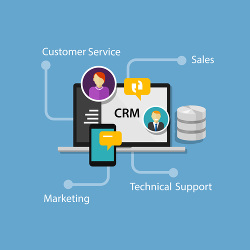
“School is a building which has four walls with tomorrow inside.” – Lon Watters
Schools and colleges are the best part of everyone’s life as they help in creating and molding the career making it valuable. The world is moving fast towards space where technology will help almost every industry from healthcare to education. Since education is more important, the focus is more on educating everyone and the technology is used at the full pace here. Many schools started using technology for simplifying everyday tasks, and few tasks have been automated to reduce confusions and hassle. Many schools and colleges started using CRM to optimize and manage their administrative data and tasks.
CRM stands for customers relationship management. It is a term that refers to the business tool that is used to organize and manage all the customers, partners, and prospects information at one end. The data organized and analyzed in the tools helps the companies to understand the business relationship with the clients and also helps in optimize the sales growth. These systems are designed to help organization compile information about the customers from various channels like website, live chat, direct mail, marketing collateral, telephones, etc. Some of the standard features of CRM system or CRM software are:

Many education organization has started using a CRM system in one way or the other to optimize and manage data. Tim Copeland, the CEO of DemandEngine said, “CRM can bring so much to the higher education market.” Even though the educational organizations have started using the CRM system, they haven’t explored the full potential of the administrative system. Copeland also added, “Many schools have deployed CRM systems for all the wrong reasons.” According to him, schools and colleges are just using CRM to send more emails to prospective students who are not the actual work of the CRM.
Many schools have a misinterpretation that CRM system would waste the staff and the management time as they do nothing the improvise the bottom line as they are only useful for sending emails to potential students. Despite these thoughts, CRMs have started to enter into the hotspot of much educational organization as the management began to see its potential. The CRMs have started helping the schools in various aspects of recruitment, communication, retention, etc.
Nowadays, the CRM vendors began to take new initiatives to make their offerings a more reliable and attractive. The following are some of the widely used trends in the CRM technology in education industry:
Earlier, a CRM system was a software used in a system placed in the organization. The scene has changed now and the system in now available on the web with the help of the cloud servers. Since the system is available in the cloud, it can be accessed from anywhere and anytime and is easy to use as they are streamlining with the new cloud-based features. The major advantage of using cloud-based CRM systems is that it facilitates a bigger storage and data sharing.
Brain Nile, the CEO and CO-Founder of TargetX said, “Centralized data storage is a real game changer.” According to him, many schools are wasting their time using N number of tools to do every task while they have an integrated CRM that does all the work. Cloud-based CRM is carried into the organizations to help them get the full the potential.
The cloud-based CRMs are not only providing web solutions but also mobility i.e. the CRMs can also be accessed from a mobile device either through the mobile browser or with the help of a mobile application that holds the functionalities of the cloud-based CRM. This advancement gives the staffs and the management to work with flexibility and to communication with the students and the constituents.
Jaclyn Esqueda Schmidt, the Coordinator of Marketing and Communications at the GSU Office of Admissions, said, “Recruiters are now in position to help prospective students through the application process, in large part because the necessary materials are immediately accessible via mobile app.” The fact is true that the customers are finding it very easy to attract prospective clients with the help of the mobile app connected to the cloud server.
The CRM software that was developed during the initial stages had bad design and didn’t reach the height as they didn’t help the customers do what they desired to do. This flaw is all because of bad interface and failing functions. The cloud-based CRMs are developed keeping users in mind, and the result was that the system was user-friendly and the system has easy-to-use tools.
Predictive analysis is one of the biggest examples of how CRM is helping schools and the related administrators perform faster. Schools have begun to use the centralized data to predict everything from the student’s applications to the enrollment to the performance. The CRMs are now capable of helping in end-to-end analytics as they have generic reporting system that provides the analytics of the data performance.
Since the CRM systems are available on the web, many web designing companies are adding their expertise to provide a system that has everything as the customers can benefit from them. The analysis system is now equipped with almost everything to help the organization get detailed analysis of every single data in the system.
Joe Burkhart, the Director of Higher Education Solutions at Oracle said, “Schools are now planning and thinking about using a CRM for managing the entire student life cycle.” The primary advantage of using CRM is that it can save hours of administrative time and optimally reduce errors by automating the tasks. They also provide accurate reporting and analytics tools to help make better decisions.